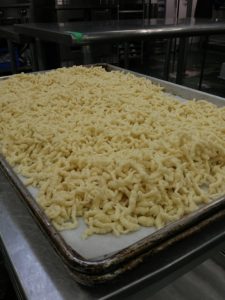 Spätzle are little dumplings. They are sometimes described as egg noodles, though they are quite different than the broad, flat, twisted dried pasta sold as egg noodles.
Spätzle are little dumplings. They are sometimes described as egg noodles, though they are quite different than the broad, flat, twisted dried pasta sold as egg noodles.
In former times spätzle were shaped by cutting small pieces of dough with a knife or spoon and rolling them into a pot of boiling water. This process gives the noodles a long, tapered, vaguely avian appearance, which is the alleged origin of their name, which literally means “little sparrows”.
Originally a specialty of Swabia in the far south-east of Germany, spätzle is now common throughout southern Germany, Switzerland, and Austria. Shorter, more rounded versions are sometimes called knöpfli, which means little buttons.

These days most spätzle is made using a special board called a spätzlehöbel. It resembles a cheese grater. It is placed horizontally over a pot of simmering water and the dough is worked back and forth along its length, slowly being pushed through the perforations in the board and dropping into the water.
Spätzle may be served immediately after cooking, or it can be cooled and reheated by re-simmering or pan-frying.
Europeans are very particular about what starches are served with what meats. I may have related this story in another post, but one time my sister and I were eating in Vienna. She ordered schnitzel, and asked if the customary parsley potatoes could be substituted with spätzle. The waiter flatly refused. Schnitzel can only be served with parsley potatoes. Spätzle is properly served with braises and other saucy preparations like goulash.
This tradition is flaunted in North American: I have seen spätzle served with everything from pork chops to baked salmon.
One very special variation deserves mention: käsespätzle, cheesy spätzle, which is basically macaroni and cheese made with spätzle noodles instead of macaroni.
Spätzle
Adapted from a recipe from Jack’s Grill. I decreased the flour content slightly to make the dough softer, and translated the measures from volumes to weights.
Ingredients
- 360 g whole milk
- 410 g whole eggs (about 8 large eggs)
- 40 g egg yolk (about 3 large yolks)
- 800 g all-purpose flour
- 6 g kosher salt
Procedure
- Combine the milk, eggs, and egg yolks in the bowl of stand mixer.
- Using a paddle attachment, mix the ingredients so that the eggs are well incorporated.
- Reduce the speed to a slow stir, then slowly start adding the flour.
- As soon as all the flour has been added and there are no dry lumps… stop mixing.
- Set up two medium pots of water over medium heat. Generously season the water with kosher salt.
- Lay a spätzle-board across one of the pots of gently simmering water. Fill the hopper with dough, and slide back and forth so that the dough is pushed through the holes and falls into the water. Spätzle is cooked roughly 30 seconds after it floats to the surface of the water.
- Once the noodles are cooked, remove from pot using a spider and transfer the to a bowl. Toss with a small amount of canola oil to prevent sticking. Spread on a sheet tray lined with parchment and let cool.
Yield: about 2 kgs spätzle
Strangely, I don’t find that resting this dough makes much of a difference at all. I often process and cook the dough immediately after mixing. That being said, the dough can also sit in the fridge over night before shaping and cooking.